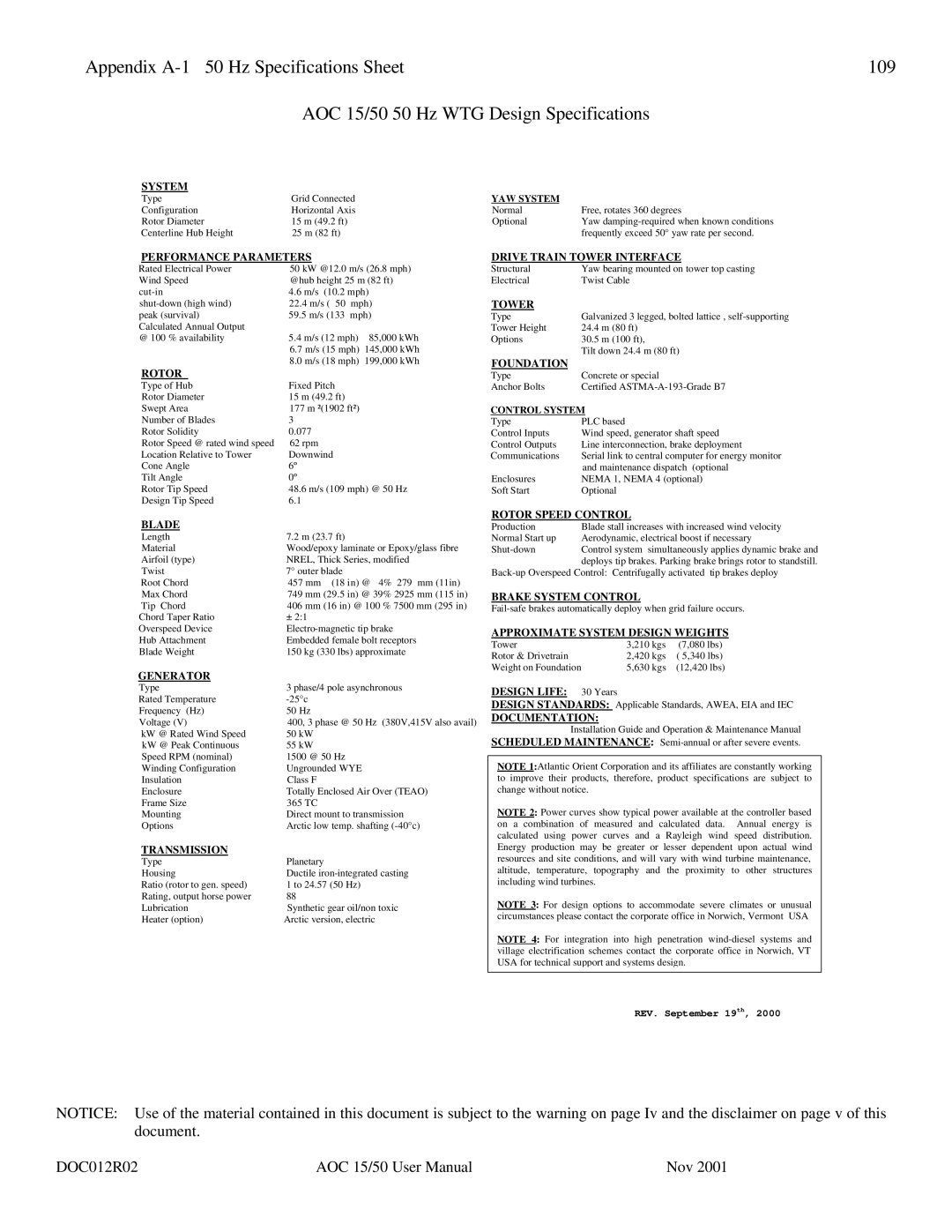
Appendix | 109 |
AOC 15/50 50 Hz WTG Design Specifications
SYSTEM
Type | Grid Connected | YAW SYSTEM |
|
Configuration | Horizontal Axis | Normal | Free, rotates 360 degrees |
Rotor Diameter | 15 m (49.2 ft) | Optional | Yaw |
Centerline Hub Height | 25 m (82 ft) |
| frequently exceed 50° yaw rate per second. |
PERFORMANCE PARAMETERS
Rated Electrical Power | 50 kW @12.0 m/s (26.8 mph) |
Wind Speed | @hub height 25 m (82 ft) |
4.6 m/s (10.2 mph) | |
22.4 m/s ( 50 mph) | |
peak (survival) | 59.5 m/s (133 mph) |
Calculated Annual Output |
|
@ 100 % availability | 5.4 m/s (12 mph) 85,000 kWh |
| 6.7 m/s (15 mph) 145,000 kWh |
| 8.0 m/s (18 mph) 199,000 kWh |
ROTOR
Type of Hub | Fixed Pitch |
Rotor Diameter | 15 m (49.2 ft) |
Swept Area | 177 m ²(1902 ft²) |
Number of Blades | 3 |
Rotor Solidity | 0.077 |
Rotor Speed @ rated wind speed | 62 rpm |
Location Relative to Tower | Downwind |
Cone Angle | 6º |
Tilt Angle | 0º |
Rotor Tip Speed | 48.6 m/s (109 mph) @ 50 Hz |
Design Tip Speed | 6.1 |
BLADE
Length | 7.2 m (23.7 ft) |
Material | Wood/epoxy laminate or Epoxy/glass fibre |
Airfoil (type) | NREL, Thick Series, modified |
Twist | 7° outer blade |
Root Chord | 457 mm (18 in) @ 4% 279 mm (11in) |
Max Chord | 749 mm (29.5 in) @ 39% 2925 mm (115 in) |
Tip Chord | 406 mm (16 in) @ 100 % 7500 mm (295 in) |
Chord Taper Ratio | ± 2:1 |
Overspeed Device | |
Hub Attachment | Embedded female bolt receptors |
Blade Weight | 150 kg (330 lbs) approximate |
GENERATOR
Type | 3 phase/4 pole asynchronous |
Rated Temperature | |
Frequency (Hz) | 50 Hz |
Voltage (V) | 400, 3 phase @ 50 Hz (380V,415V also avail) |
kW @ Rated Wind Speed | 50 kW |
kW @ Peak Continuous | 55 kW |
Speed RPM (nominal) | 1500 @ 50 Hz |
Winding Configuration | Ungrounded WYE |
Insulation | Class F |
Enclosure | Totally Enclosed Air Over (TEAO) |
Frame Size | 365 TC |
Mounting | Direct mount to transmission |
Options | Arctic low temp. shafting |
TRANSMISSION
Type | Planetary |
Housing | Ductile |
Ratio (rotor to gen. speed) | 1 to 24.57 (50 Hz) |
Rating, output horse power | 88 |
Lubrication | Synthetic gear oil/non toxic |
Heater (option) | Arctic version, electric |
DRIVE TRAIN TOWER INTERFACE
Structural | Yaw bearing mounted on tower top casting |
Electrical | Twist Cable |
TOWER
Type | Galvanized 3 legged, bolted lattice , |
Tower Height | 24.4 m (80 ft) |
Options | 30.5 m (100 ft), |
| Tilt down 24.4 m (80 ft) |
FOUNDATION
Type | Concrete or special |
Anchor Bolts | Certified |
CONTROL SYSTEM | |
Type | PLC based |
Control Inputs | Wind speed, generator shaft speed |
Control Outputs | Line interconnection, brake deployment |
Communications | Serial link to central computer for energy monitor |
| and maintenance dispatch (optional |
Enclosures | NEMA 1, NEMA 4 (optional) |
Soft Start | Optional |
ROTOR SPEED CONTROL
Production | Blade stall increases with increased wind velocity |
Normal Start up | Aerodynamic, electrical boost if necessary |
Control system simultaneously applies dynamic brake and | |
| deploys tip brakes. Parking brake brings rotor to standstill. |
BRAKE SYSTEM CONTROL
APPROXIMATE SYSTEM DESIGN WEIGHTS
Tower | 3,210 kgs | (7,080 lbs) |
Rotor & Drivetrain | 2,420 kgs | ( 5,340 lbs) |
Weight on Foundation | 5,630 kgs | (12,420 lbs) |
DESIGN LIFE: 30 Years
DESIGN STANDARDS: Applicable Standards, AWEA, EIA and IEC
DOCUMENTATION:
Installation Guide and Operation & Maintenance Manual SCHEDULED MAINTENANCE:
NOTE 1:Atlantic Orient Corporation and its affiliates are constantly working to improve their products, therefore, product specifications are subject to change without notice.
NOTE 2: Power curves show typical power available at the controller based on a combination of measured and calculated data. Annual energy is calculated using power curves and a Rayleigh wind speed distribution. Energy production may be greater or lesser dependent upon actual wind resources and site conditions, and will vary with wind turbine maintenance, altitude, temperature, topography and the proximity to other structures including wind turbines.
NOTE 3: For design options to accommodate severe climates or unusual circumstances please contact the corporate office in Norwich, Vermont USA
NOTE 4: For integration into high penetration
REV. September 19th, 2000
NOTICE: Use of the material contained in this document is subject to the warning on page Iv and the disclaimer on page v of this document.
DOC012R02 | AOC 15/50 User Manual | Nov 2001 |
